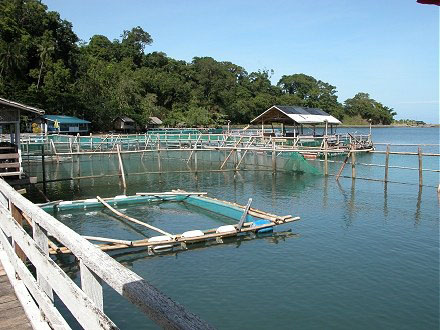|
Pond Management
Farming in earthen ponds
The ponds where milkfish fingerlings are reared are called “production ponds”
or “rearing ponds”. The production pond ranges from 0.5 ha to 3 ha in
area and are rectangular in shape, with water depth ranging from 0.3 to 0.7 m. The
best bottom for these ponds is a soft, jelly like, colloidal and biologically active
mud containing about 4% humus and large amounts of clay. The silt, sand and clay
should be in the proportion of 64%, 32% and 4%. In Taiwan, a system of canals is
provided on the outer boundary of the ponds to give protection to fish against extreme
conditions of temperature.
About two months prior to stocking, the pond management begins for augmenting the
growth of blue-green algae in pond bottom. These are similar to those practiced
in nursery pond viz., draining of the water, drying, tilling, leveling and raking.
Manuring of the ponds is always carried out. Usually, green manure is used, such
as leaves and twigs of mangrove plants, rice straw, copra, rice bran, oilcakes,
pig manure, chicken manure etc. The rate of fertilization usually varies from 500
to 2,000 kg/ha. Beside organic manure, inorganic fertilizers containing nitrates,
phosphates and potassium (NPK) such as superphosphates, triple superphosphates,
urea etc may also be applied at required rates. Water is then let into the pond
and the depth is increased to about 30 cm gradually. Within two weeks the algal-periphyton
complex (Lab-lab) develops at the pond bottom. Stocking in earthen pond follows
only after the growth of Lab-lab. Usually fingerlings of 7 to 15 cm length are stocked
at a rate of 2,000 to 10,000 per ha. When the growth of Lab-lab in the pond decreases,
fresh dosages of manure are added.
Farming in pens
Inexpensive pen structures for farming the milkfish are constructed in shallow natural
creeks, swamps, lagoons, lakes and bays, ranging in depth from 1 to 3 m. The bottom
in pen culture sites should be of firm clay or mud so that poles and posts can be
driven sufficiently deep to make them support the pen structure. Traditionally pens
are made up of wooden planks, split bamboo etc. But in recent times, nets materials
made of synthetic materials such as nylon, polypropylene, polythene etc are used
commonly. A part of the vertical net barrier is buried inside the mud or ground
with the aid of a footrope and small weights, secured to a chain link between concrete
sinkers. At the upper level, floats are provided. Fingerlings stocked in usually
feed upon the natural food in the lagoon or lake and no artificial food is provided.

Pen culture of milkfish
Eradication of predators and pests
Certain predatory fishes, crabs, water snakes are the common threat to milkfish
culture ponds and pen structures. These can be prevented from entering the farming
area through use of fine meshed screens. Apart from these larvae of certain insects
also pose threat to fingerlings of milkfish. Application of 0.5 ppm Baluscide, lime,
urea etc. in the initial preparation of the ponds helps to reduce their growth.
Harvesting
Milkfish has a higher growth rate in its first year in brackishwater, during
when it grows to a marketable size of 30-45 cm long and 300-800 gm in weight. The
periodicity of harvesting depends upon the number of batches stocked. During harvesting
the pond is drained using pumps, while in the case of pens, the lowest tidal period
is the best time for harvest. If trenches were provided in culture ponds, it would
be easier to gather all the fish inside the trenches by draining the water and then
capturing them. Usually, seine nets are operated for capturing farmed fish. The
survival rates ranges from 80 to 95% amounting to a production ranging from 500
to 1000 kg/ha in ponds and 250 to 500 kg/ha in pens.
Top
|